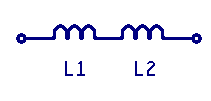This is Book 2
Chapter 7 - AC and Hertz
Chapter 8 - Magnetism
Chapter 8.2 - Inductors
Chapter 9 - Power Supply
Chapter 9.2 - Power Supply Filters
Chapter 10 - IC's and Amplifier
Chapter 10.2 - OP AMP Feedback and Unity Gain
Chapter 10.3 - OP AMP Non-Inverting
Chapter 10.4 - OP AMP Inverting
Chapter 11 - 555 Timer
Chapter 11.2 - Counters
Chapter 12 - Logic
Back To The Guide
Take Me Home
Inductors In Series
When inductors are in series in a circuit, the current will flow equally
through the series of inductors. The total inductance for the series is
calculated by adding the values of all series inductors together. This is
similar to way that series resistors are calculated.
The formula for inductor in series is L-equivalent = L1 + L2.
If L1 equals 3 millihenrys and L2 equals 2 millihenrys the total is 5 millihenrys
Inductors In Parallel
Similar formulas are used for Inductors wired in a circuit when they are parallel
as resistors use when they are in parallel. For indictors in parallel this is
similar to calculating resistors in parallel.
L-equivalent= ( 1 / ( ( 1/L1 )+( 1/L2 ) ) )
If L1 equals 3 mH and L2 equals 2 mH the total is 1.2 millihenrys.
If L1 equals 3 mH and L2 equals 2 mH the total is 1.2 millihenrys.:
1. Core material: Some core materials including Iron are more able to support
flux lines over materials like open air cores. This ability to support flux lines
means iron cores will have more inductance and air cores will have less inductance.
2. Diameter of core: The larger the diameter of the cores cross-sectional area the
more lines of force exist and the greater the inductance. Even if the turns
count remains the same, increased core diameter will increase the conductor linear
surface area and this will increase the inductance.
3. Increased turns: Increasing the turns in the core will increase the inductance.
4. Tightly wrapped coil. The tighter the coil is wrapped the more inductance
will be created
Inductive Reactance (XL)
Both resistance and the change in flux lines in inductance are in oppositions
to current flow
In a pure resistance circuit, the resistance to current flow, in Ohms, is the
same in both direct current (DC) and alternating current (AC) circuits
This is not the same for inductance. The Ohms of resistance for inductors in a
circuit is directly proportional to the AC frequency of the waveform in that circuit.
This AC resistance uses the special name of Impedance. Like
resistance, Impedance opposes the flow of current. For any given inductance
value, the inductor blocks more current flow and passes less energy as the
frequency increases. As with all electronics there is a formula that represents
this reaction to frequencies.
Inductive Reactance (XL) formula is XL = 2 Π f L
In short Inductive Reactance is the impedance (AC Resistance)
of an inductor at a specific frequency.
Where: XL is the AC resistance to current flow
2 Π is a constant of 2(3.14159)
f is the frequency of the voltage in Hz
L is the inductance of the coil in Henrys
Example: Given a 10mH coil of wire, apply three different frequencies
and record the three different impedance calculations.
The inductance is 10mH (0.010 Henrys)
The frequencies are 60 Hz, 400 Hz and 1kHz
The formals are: XL = 2 Π f L
For 60 Hz - XL = (2)(3.14159)(60)(0.010) or XL = 3.77 Ω
For 400 Hz - XL = (2)(3.14159)(400)(0.010) or XL = 25.13 Ω
For 1k Hz - XL = (2)(3.14159)(1000)(0.010) or XL = 62.83 Ω
As the frequency moved from 60Hz to 1KHz the AC resistance
increases from 3.77 to 62.83 Ohms.
Example: Given a 1 Henry coil, and the same three frequencies
record the three different impedance calculations.
For 60 Hz - XL = (2)(3.14159)(60)(1) or XL = 377 Ω
For 400 Hz - XL = (2)(3.14159)(400)(1) or XL = 2.5 k Ω
For 1k Hz - XL = (2)(3.14159)(1000)(1) or XL = 6.28 k Ω
There are other factures that we are not considering at this time including
the amount of current the coil can carry.
In summery a conductor which is passing by a magnetic flux field, will generate
a voltage, and within a circuit, current will flow. Conversely when current
flows through a conductor an electromagnetic
field (magnetic flux) is created. If two or more independent coils of wire
are placed in close proximately to each other and one coil has a varying current flowing
through it, it will induce a current to flow in the other coil(s) in circuit(s). The
multi-coil arrangement is called a transformer. The principle of transferring
energy into the second coil is called induction. In inductors, the Ohms
resistance to a change in current flow is called impedance. The inductors impedance
increases proportionately with frequency. The inductors impedance increases
proportionately with its increase in inductance.
« Previous Chapter Next Chapter »
Email us: info@shoeboxkits.com


